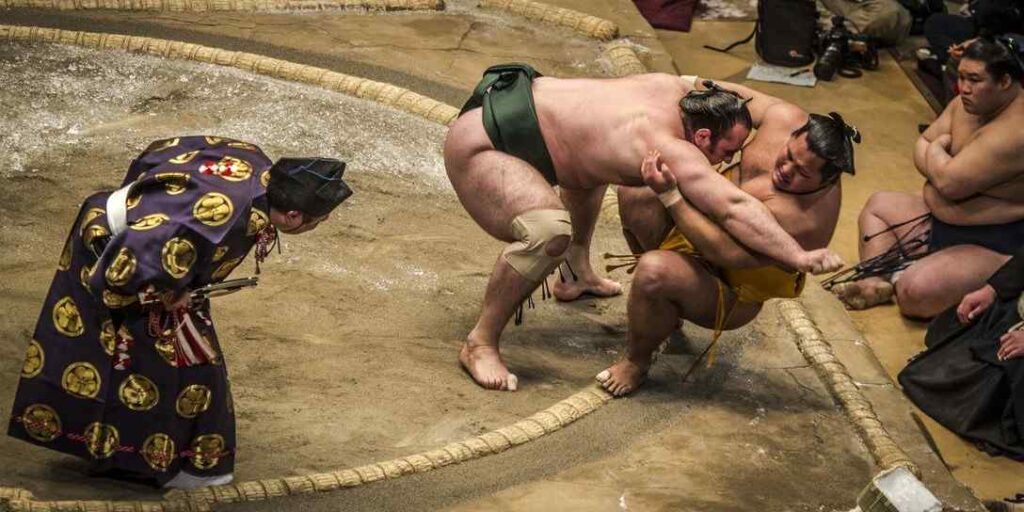What is the purpose of Sumotori wrestling? Learn about the facts, different rites, and practices that are part of Japanese culture.
Japanese society is full of different kinds of people. The country has a lot of different kinds of culture, from comics to sushi to geishas and ramen. This is the reason why Japan gets so many tourists every year from all over the world.
Sumotori or Sumo Heart of Japanese Culture
Manga and geishas are often brought up when talking about Japanese culture. And when it comes to food, sushi, and ramen are the stars.
But when we talk about tradition, we can’t leave out Sumotori, a form of martial arts in which two very big fighters compete against each other.
People in Japan love this sport, which has been around for hundreds of years. It has always been a sign of how unique Japanese society is because it has a strong connection to Shintoism. There are rumors that this sport comes from a Japanese god.
Sumotori Wrestling Facts
Japan has a lot of movies that show sumo. Japan is where manga was first made, so there are even short films based on sumo comics.
But how did this sport come about? Since it turns out to be a holy building, does it really come from the Japanese gods?
It’s clear that sumotori has been around for a long time. There is a martial arts element to it, but it is very different from the martial arts we know.
On the one hand, this practice is very exclusive because only Rikishi is allowed to take part. Someone who does sumo is called rikishi in Japanese.
A young person who wants to make a living as a sumo wrestler will have to dedicate himself to the art from the time he is a teenager.
In this way, he will become part of the heya, which is a sumo house where he will live with other rikishi. Chankonabe, a stew that is high in protein and will help him gain weight and strength, will be the main food he has to eat.
For this reason, they must weigh at least 140 kg. Like most Japanese people, rikishi has to follow the rules. In addition to getting up at 5 a.m. to start an intense workout called Keiko, they will have to clean their rooms and sweep and rake the floor.
Basic Idea Behind Sumotori
Sumo is different from other sports in more ways than just weight. Rikishi is a fighter, and his feet are as quick as a ninja’s.
How are they? They have to do a lot of stretching every morning at five o’clock during their workout. People do these stretches in groups and are very careful.
What makes a rikishi strong is also how well they do their job. It is also important for the Rikishi to learn the 82 holds that make up this sport.
There is also an order to follow in a heya. The younger ones should serve and help the older ones. It’s up to them to cook the rice and do all the other jobs around the house.
Also, like all other sports, sumotori has different levels, in this case 6 levels. The Yokozuna are at the top of the ranks, but only a very small number of people who reach this level are considered divine.
You can choose from Akashi Shiganosuke, Shiranui Dakuemon, Shiranui Kôemon, or even Jinmaku Kyûgorô as the most important Yokozunas in history. To give you some background, a sumo cartoon that shows a yokozuna fighting came out a few years ago.
Sumos fight in a ring that people in Japan call “Dohyo.” They stand facing each other without shoes on and only wear a Mae-tate-Mitsu (a thong) and a Mawashi (a belt).
According to custom, a rikishi’s hair is worn in a bun that changes based on their rank. Also, each wrestler must have his fighting name or Shikona with him at the time of the fight.
Sumotori Wrestling Rules
As was already said, sumotoris fight in a ring that stands for the sky. Keep in mind that the Dohyô is 6 m², but the fight happens in a 4 m circle in the middle of the ring.
And before the two fighters can face off, they have to go through a number of rituals. The rikishi must first clean his body and mind because every fight is a way to respect the gods.
He should also use clean water to rinse his mouth and a paper towel to dry himself. That being said, the fight can happen now. When one of the rikishi is able to push their opponent out of the ring circle, the fight is over.
It’s not always necessary to wear a mask. Simply because punches, kicks above the hips, and strangulations are not allowed in this discipline. It is also against the rules to grab your opponent with your Mae-tate-Mitsu.
Sumotori Wrestling History
This kind of control has been around for a while. Since the time of the gods, it has been around. The Kojiki first wrote about it in 712.
Later, sumotori would be used as a rite in farming, and the fights would go all the way to the death because hitting was illegal.
It became a part of Japan’s royal court in the 8th century, but it was no longer seen as a ritual for farmers. On the contrary, it stood for happiness and peace.
The government recognized it as a fighting art in the 9th century. During the Edo era, it changed into a more developed form, which is how modern sumo came to be.
Also Read: 10 Best Gaming Headsets



